There are a lot of studies floating around concerning different personality types or people with certain character traits gravitating toward the same area to work and live. They suggest there might be certain features of certain places that attract certain types of people.
Obviously, without care, this perspective can be easy to oversimplify. It must be true that some people locate themselves for reasons other than the preferences their traits might bring to the surface. There are plenty of explanations as to why people might find themselves in particular places that have nothing to do with traits: families, jobs, convenience, lack of opportunity at the places where they would like to be... to name a few.
Nonetheless, there were some intriguing outcomes from our analysis of the 617,000 people who took the personality test at 16Personalities.com when the results were sorted by state in the United States. For example: Why is it that those who test as more adventurous types have a stronger presence in the northern states (see “Explorer” map below)?
In a short article, it’s hard to provide a thorough analysis of all the possible interpretations and speculations. Nonetheless, the overview that follows provides personality climate maps for us to explore. This research also provides a springboard for future studies, as it raises many interesting questions.
Please share your thoughts in the comments section afterwards, as we always look forward to your feedback. Let’s get started!
Type Roles
Analysts
Analysts rely strongly on rationality and their intuitive ability to gather and interpret information and knowledge quickly. They decide things based on logic with little influence coming from their emotions. In fact, expressing emotions can be a point of difficulty for some among them. Systems and big theories grab their attention, and these personality types like to think about improving both.
However, it’s important to stress that Analysts do feel, and that those who aren’t Analysts do think. The difference is simply the filter they prefer to use for decision-making.
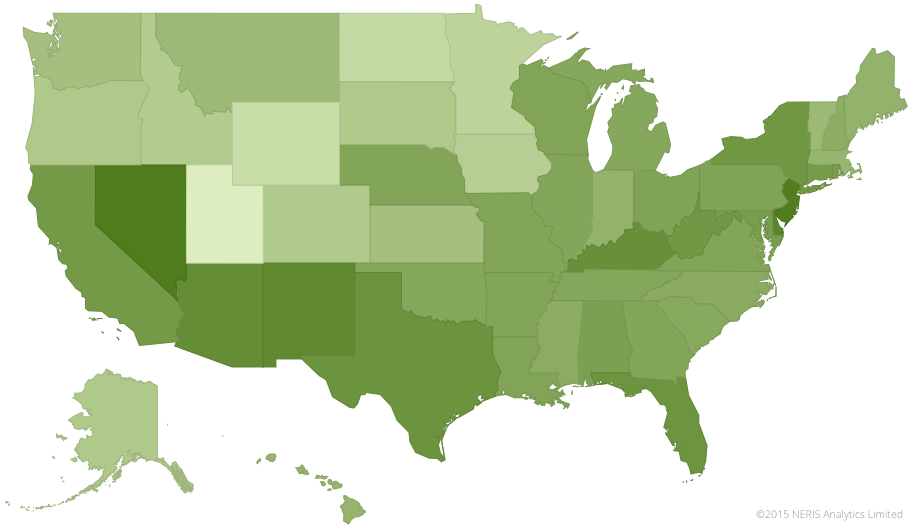
States and Regions:
Analysts are tough-minded individuals who delight in improving things, especially systems. The desert cluster (Nevada, Arizona and New Mexico) and an Appalachian cluster (Kentucky and West Virginia), along with New Jersey and Texas, speak to this tough-mindedness. Utah and Wyoming rank among the lowest for Analysts. However, they rank highly among the types who decide more through their emotional filters as highlighted on several of the maps again and again.
New Mexico has an interesting overlap with both Analysts and Diplomats being strongly represented. Intuition is the common trait in both groups. While the state’s nickname is officially “The Land of Enchantment”, they might also consider calling it “The Land of Intuition”.
Maps of Analyst Types:
Architects (INTJ-A / INTJ-T)
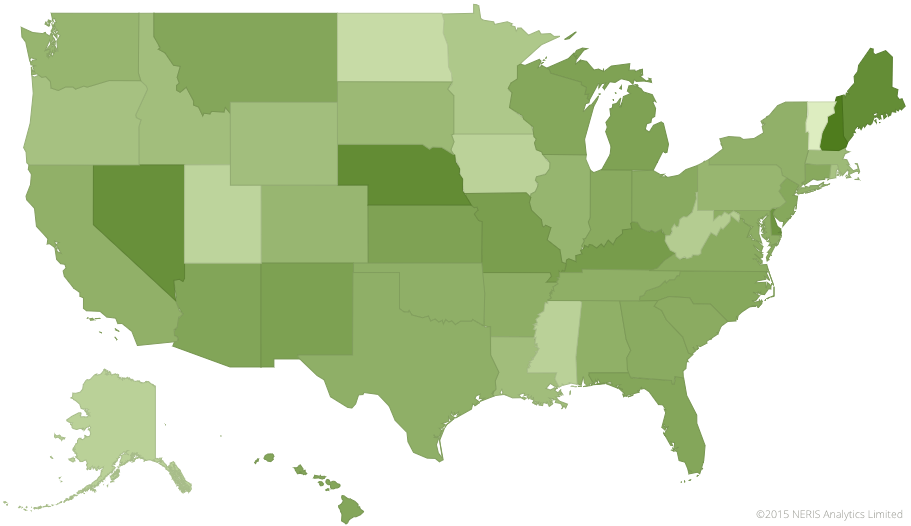
Logicians (INTP-A / INTP-T)
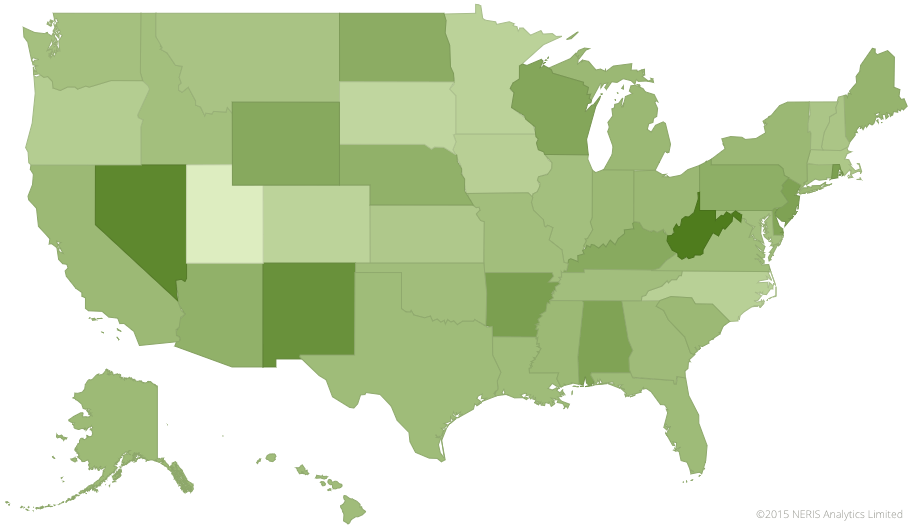
Commanders (ENTJ-A / ENTJ-T)
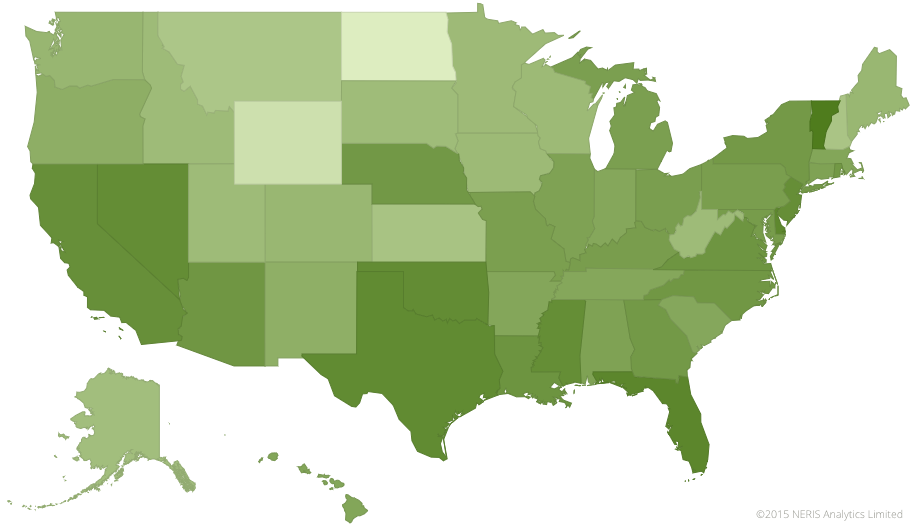
Debaters (ENTP-A / ENTP-T)
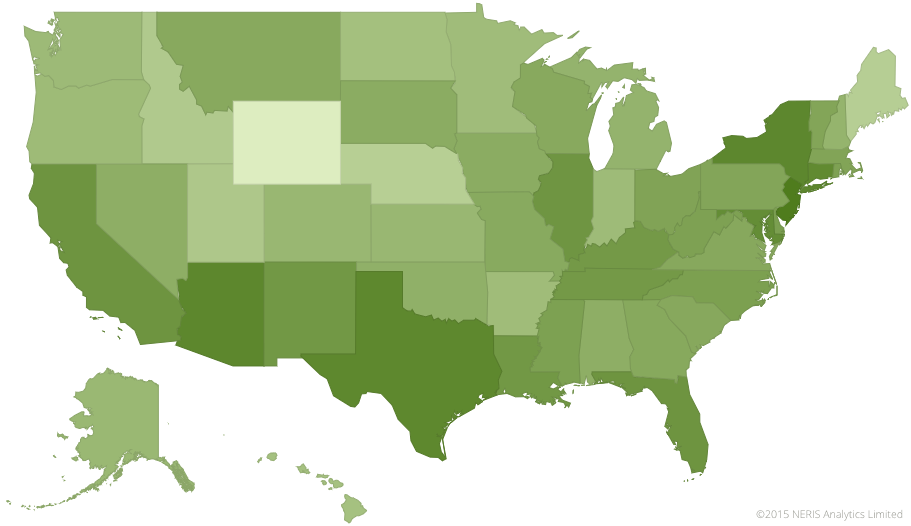
Diplomats
The core of the Diplomat personality is their reliance on their intuition and their emotions. They are people- and cause-oriented. They “read” people quickly and their empathy for others influences them greatly. They are imaginative individuals who are not always attentive to details, preferring a “big picture” view of things. Sometimes these personality types romanticize life a bit too much and can be dreamers. Diplomats look to the future for a better day for themselves, their communities and, for that matter, all of humanity.
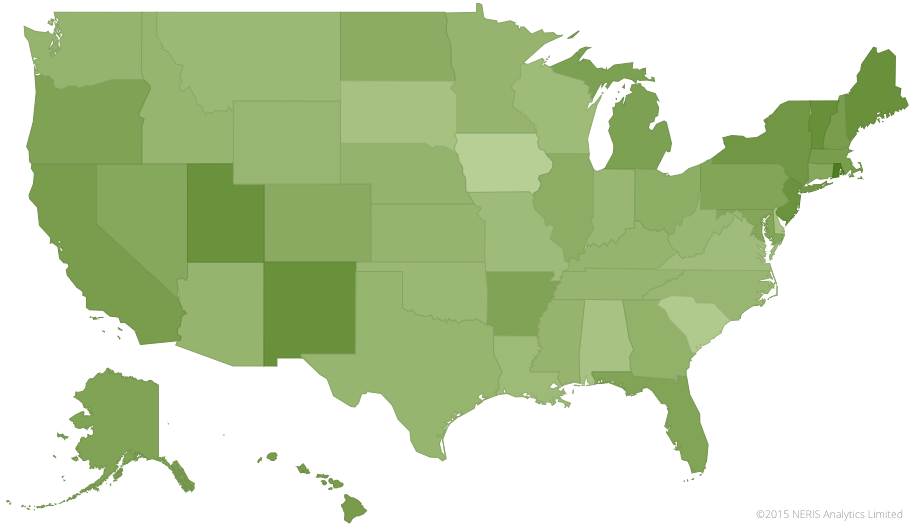
States and Regions:
By our survey, Diplomats find themselves more comfortable in the Northeast, especially Rhode Island, and Michigan. The West also attracts these visionary types.
Note the strong showing of Diplomats in New Mexico. In the discussion that follows, New Mexico appears again and again as strongly sharing common traits, especially Intuition (see Analysts above).
Florida has the reputation of being home to a lot of people who migrate to its warmer climate from the Northeast – many after retirement. Accordingly, Florida is often more aligned with the New England states and New York than their southern state neighbors on these maps. It’s almost as though they were a tropical outpost of northeastern personality types. Diplomats affirm that trend on this map.
Compare the number of Diplomats from Utah and Wyoming with the number of Analysts. Over and again, these two states rank highly among those who rely more on their feelings when delivering decisions. One might speculate the family and community focus of the Mormons in Utah and Wyoming account for at least some of this trend.
Maps of Diplomat Types:
Advocates (INFJ-A / INFJ-T)
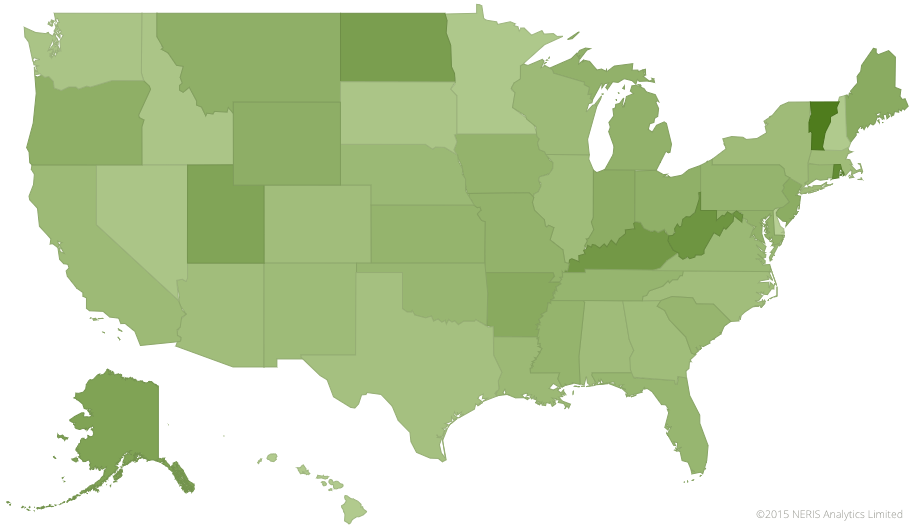
Mediators (INFP-A / INFP-T)
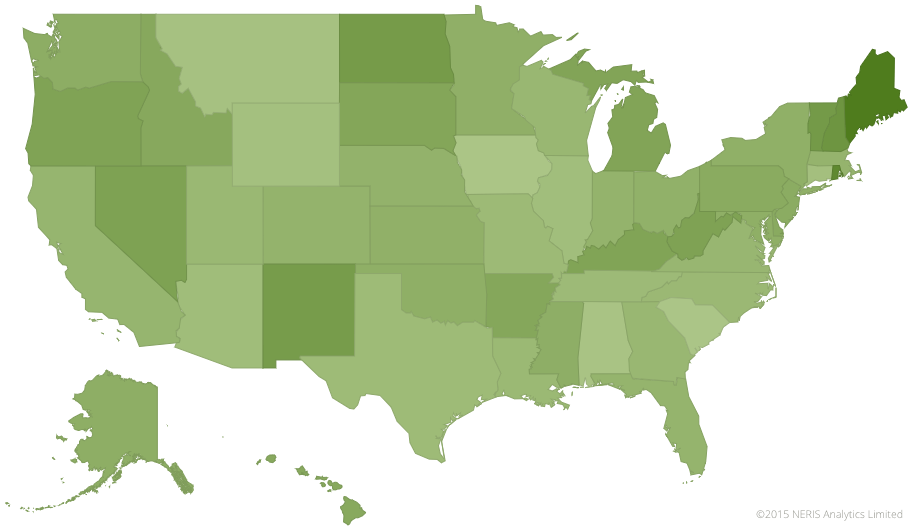
Protagonists (ENFJ-A / ENFJ-T)
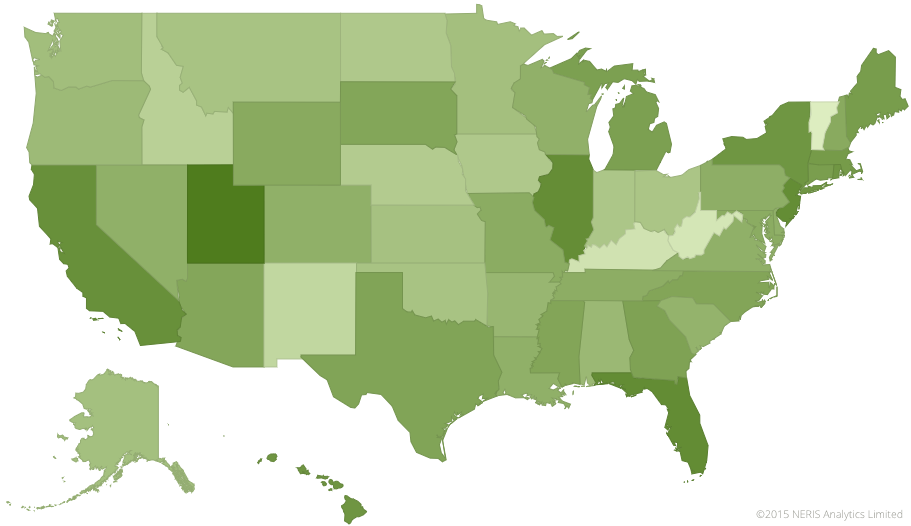
Campaigners (ENFP-A / ENFP-T)
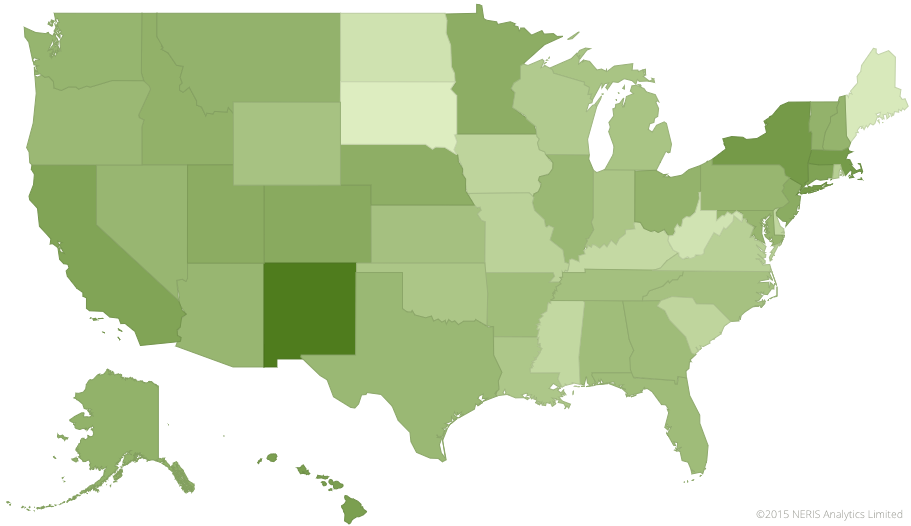
Sentinels
Sentinels are the practical people who approach life based on long-standing principles and traditions. They work hard and pride themselves on their reliability. They are masters of logistics, organization, and order, and along with their continuity with the past, these personality types are a stabilizing force in society balancing out more progressive ideas. They can at times be too rigid and judgmental, but it’s simply because they hold firmly to things they believe and trust. There’s little room for variation for them when it comes to those things. These personalities are not easily swayed when they believe something is right.
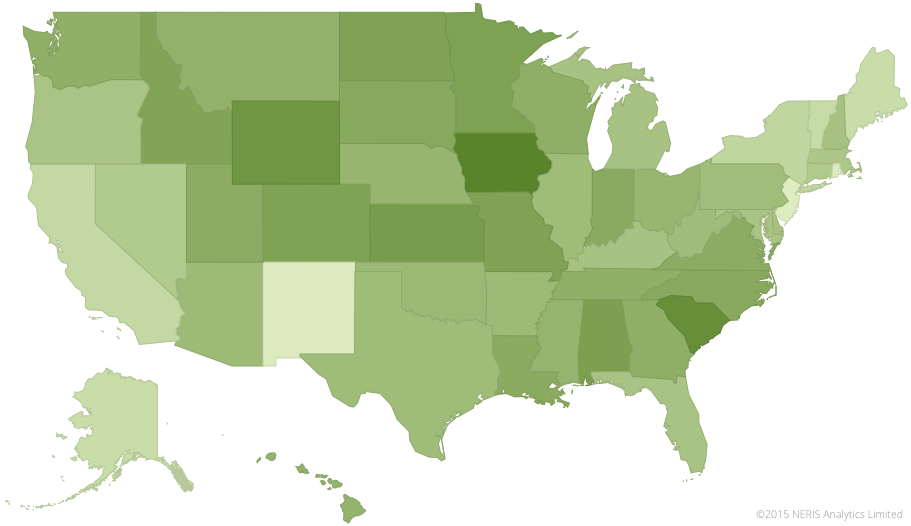
States and Regions:
On this map, the Farm Belt meets the Bible Belt and reflects the strongest representation of Sentinels in the United States. Both regions have a reputation for their Sentinel-like “neighborliness”, hard work and their respect for traditional values.
It’s interesting that two of the states that are most green also coincide with the states polled as most religious. Alabama is the third most religious state and South Carolina the fifth. (First, second and fourth – Mississippi, Utah and Louisiana – also have strong Sentinel presence.) While religious adherence is not an essential characteristic for being a Sentinel, their love of tradition and fixed values readily align them with religious beliefs and institutions.
It’s also interesting how much the darker green on the Sentinel map mirrors the Red States (Conservative Republican bastions) on the U.S. political map. Diplomats, with their eye toward a better future, also reflect the same with Blue states (Liberal Democratic areas). Political conservatives usually desire to hold to more traditional values and the “way things used to be”. Some have called them “values voters”. It’s perhaps a name that Sentinels would readily approve of for themselves.
The state least represented by Sentinels is the highly intuitive state of New Mexico. The Northeast and West also account for fewer Sentinels. Most would characterize those regions as more liberal in their thinking, with a reputation for openness to new ideas.
Maps of Sentinel Types:
Logisticians (ISTJ-A / ISTJ-T)
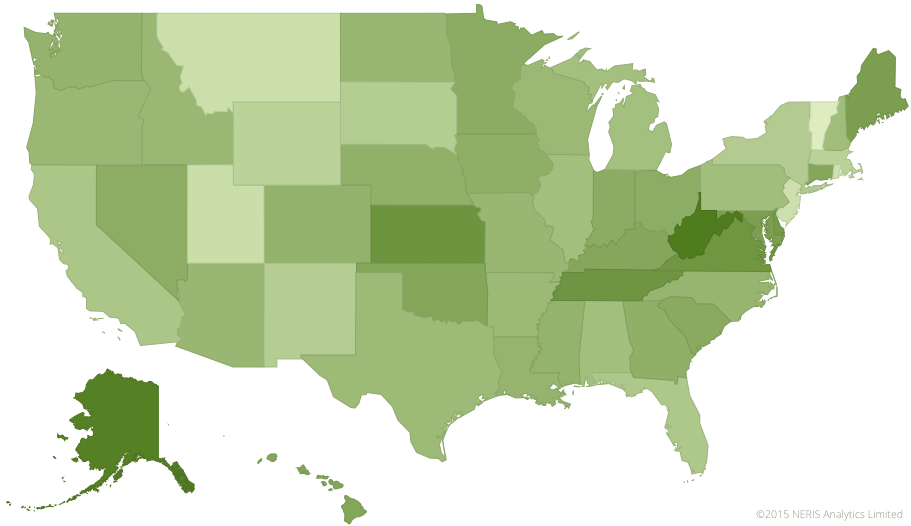
Defenders (ISFJ-A / ISFJ-T)
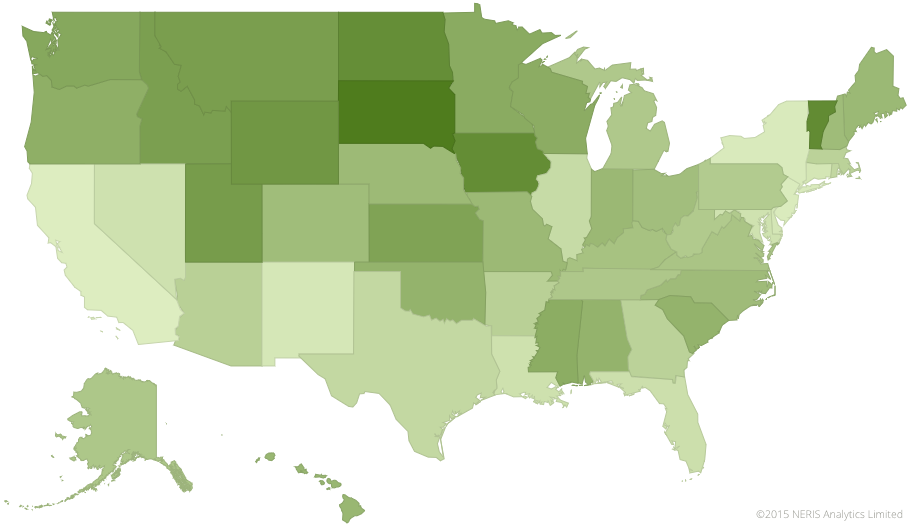
Executives (ESTJ-A / ESTJ-T)
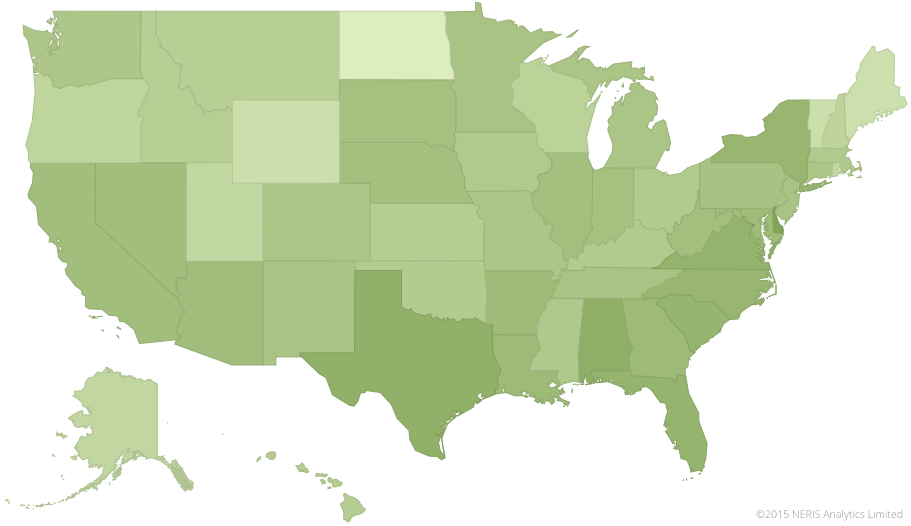
Consuls (ESFJ-A / ESFJ-T)
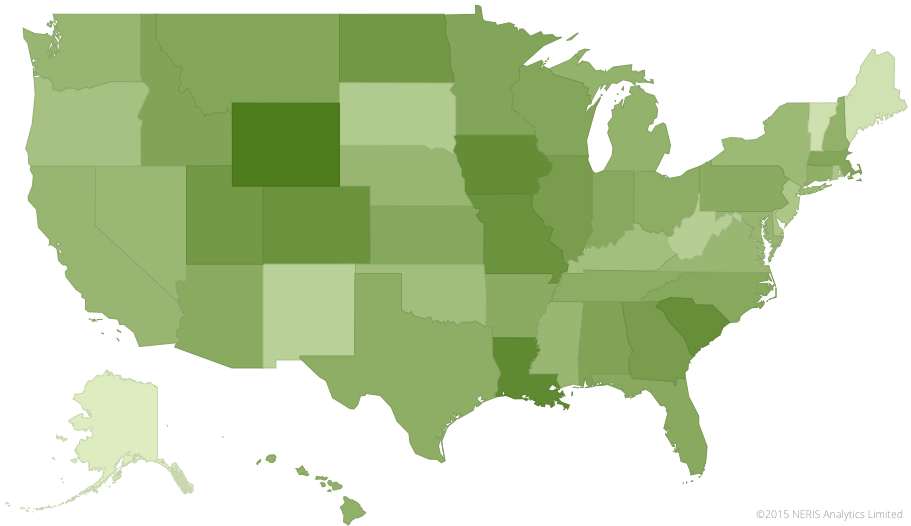
Explorers
Explorers are the craftspeople and adventurers of the personality types. Things that are novel attract them – they constantly look for the next newest thing. Their voracious desire to master anything that catches their interest sets them apart as the skilled people they are. These personality types can sometimes be mavericks in life, as they live in the moment and discount rules that don’t work for them. They take risks more easily than others. They are usually effective people who put in an enthusiastic effort to solve problems. While people of other types do not always appreciate their ways, Explorers usually receive recognition for their bold solutions and their willingness to act quickly when needed.
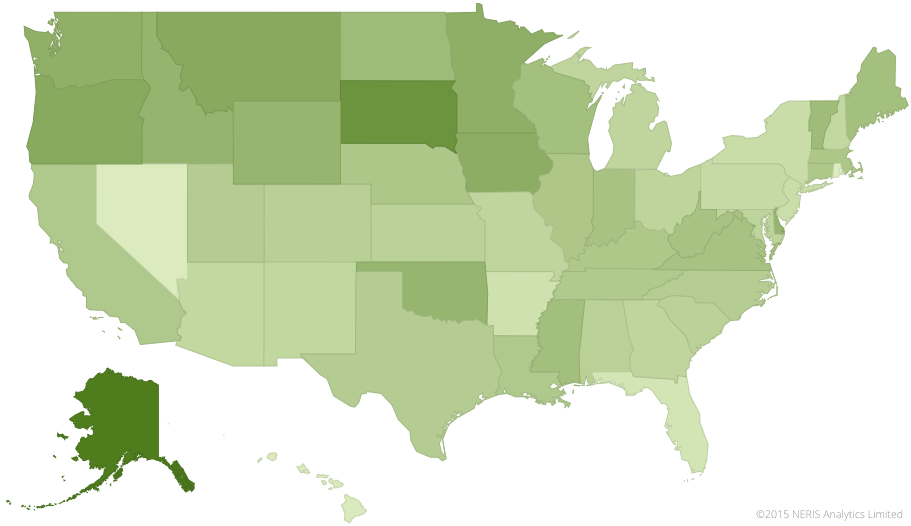
States and Regions:
Anyone who has read any Jack London or who has even watched any of the many reality shows about Alaska will understand why the state attracts Explorers. The Explorers’ self-reliance, with their need to use skills and their fondness for discovering the undiscovered, fit well with Alaska’s reputed character.
Then, there’s Delaware. It’s not exactly Alaska, safely tucked between New Jersey and Maryland as it is. Yet it has one of the highest densities of Explorers in our responses. One does not think of high adventure when one thinks of Delaware. However, much goes on in the robust little state, from manufacturing to farming to fishing. Because of these, Explorers’ taste for skilled work may account for the large percentage of them in Delaware.
Vermont and Oregon, also highly represented, have reputations for attracting freethinkers and harboring those with alternative lifestyles. Some call Portland, Oregon a “hipster magnet”. Art, coffeehouse culture, quirky politics, vibrant music scenes and artisan interests of various kinds, prevalent in these states, may account for the density of Explorers. There are many natural resources to manage, and forestry is important to the three places that would be appealing to Explorer types. (A friend from Oregon says the Explorer presence is a remnant of an Oregon Trail mind-set that fosters individualism and exploration.)
Finally, our survey suggests the more northward one chooses to live, the more likely they are to be Explorers. Perhaps the challenging land and weather appeals to the adventurous, problem-solving souls from among this group.
Maps of Explorer Types:
Virtuosos (ISTP-A / ISTP-T)
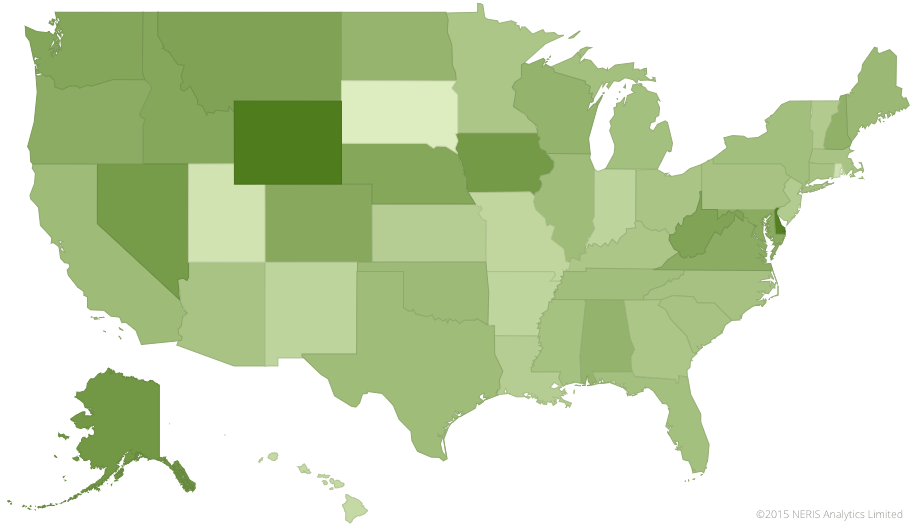
Adventurers (ISFP-A / ISFP-T)
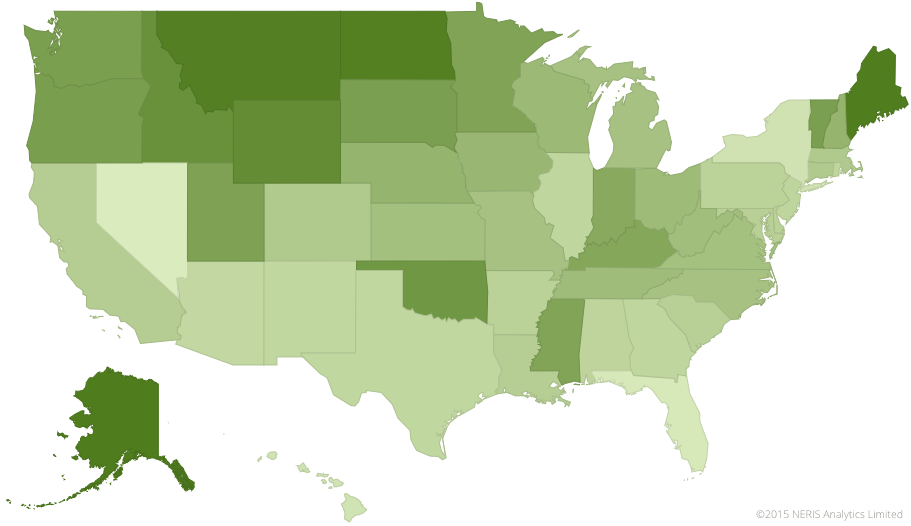
Entrepreneurs (ESTP-A / ESTP-T)
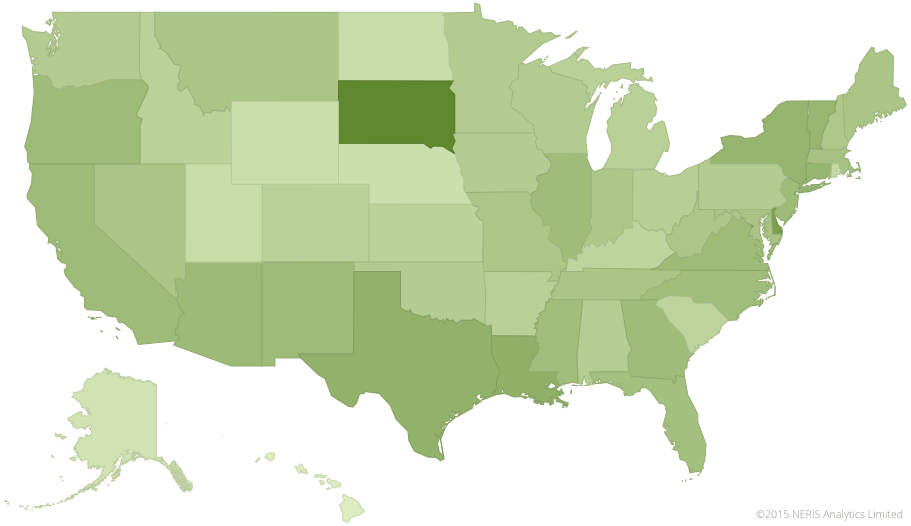
Entertainers (ESFP-A / ESFP-T)
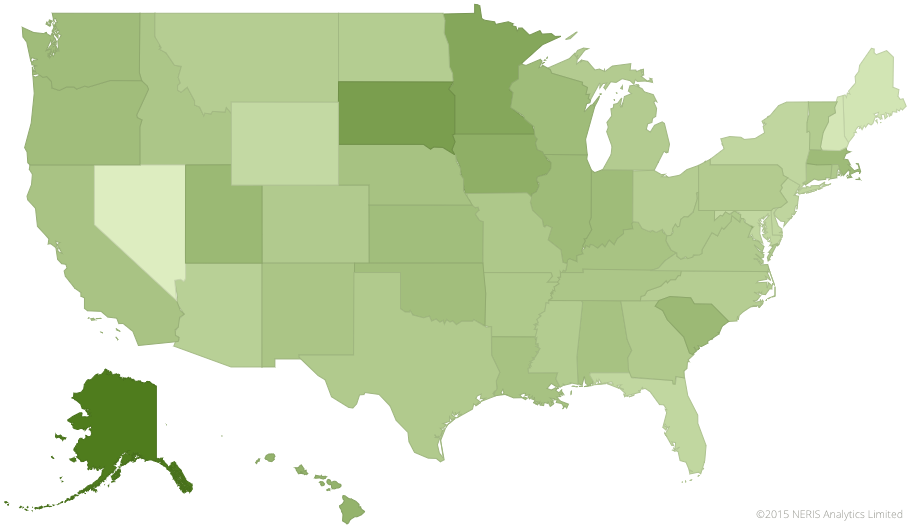
We will cover type strategies in a separate article a bit later – stay tuned.
Traits
Let’s break this down more and look at the individual traits that make up the roles and the personality types themselves, and explore the degree to which they are present in states and regions.
Extraverted / Introverted
The average reader these days is familiar with the definitions for extraversion and introversion. Mainly, extraverts are those who gain energy from interacting with the outside world, especially other people. Introverts gain energy from time alone or in quiet, intimate settings. Extraverts manage well in environments that are noisy and busy and often seek them out. Introverts are more sensitive to external stimulation and avoid or retreat from “louder” environments.
Extraverted (more purple) vs. Introverted (less purple)
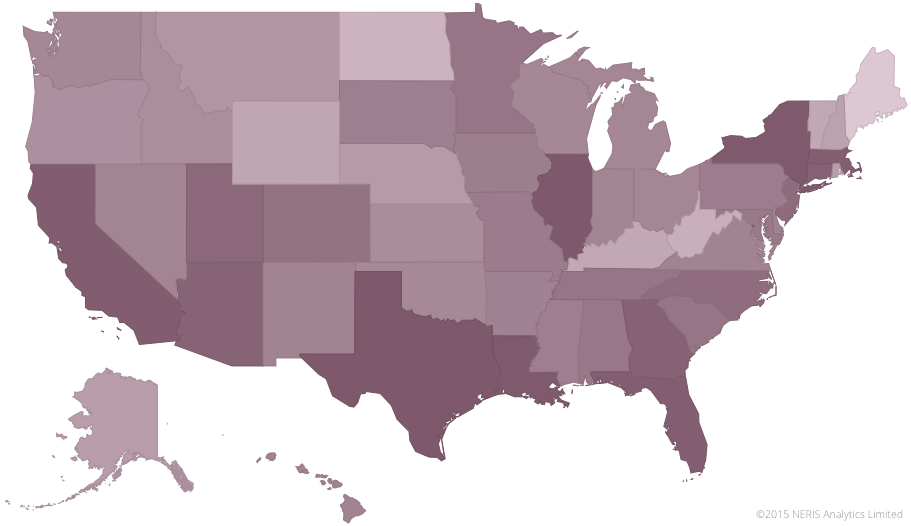
States and Regions:
Is it any surprise that the four states with the four largest cities are among those at the top of the list of “extraverted states”? In order of city population, New York (NYC), California (Los Angeles), Illinois (Chicago) and Texas (Houston) seem like logical draws for people energized by other people. But what about Arizona, South Dakota and Wisconsin?
How much does the culture of an area come into play? Anyone who has ever been to Mardi Gras or spent any time with the gregarious Cajuns will not argue with Louisiana (New Orleans) coming in a darker purple on the map. Perhaps some cultural factors explain those other states that aren’t intuitively easy to label as “extraverted”.
Looking at it from the introverted individual’s view, Alaska, Wyoming, Montana and North Dakota are the four states with the least population density, which also happen to have the smallest percentage of extraverts. Maine is 38th on the list of declining population density. It seems natural that a place with fewer neighbors would draw in introverts.
Intuitive / Observant
These traits are the way that individuals process the world and collect information. Intuitive people work like an intellectual sponge as they soak up information almost spontaneously. They lean more toward theories and are imaginative thinkers. Observant people are much more practical. They observe the world around them and collect information with their senses. They lean more toward concrete activities and toward trusting things that are time-tested. For those who are familiar with the Big Five dimensions of personality, this particular scale is likely to correlate with the Openness to Experience factor.
Intuitive (more purple) vs. Observant (less purple)

States and Regions:
It’s official. New Mexico, the Land of Enchantment, is unofficially the United States’ intuition capital. Regionally, the South West and the Northeast have a greater density of people testing as intuitive. On the other hand, the practical Upper Mid-West and Southeast are at the other end of the scale – once again conforming to other maps of cultural and political ideologies.
Considering Analysts and their healthy intuition, the Northeast and the West offers a dense concentration of colleges and universities. Not only do they send bright minds out into the world more educated, but they also conduct a lot of research in both regions. The top industries in both California and New Jersey are technology- and research-heavy. Silicon Valley, just south of San Francisco, is home to many of the high-tech companies that keep our digital world humming.
And let’s not forget our “imaginative dreamers”, the Diplomats. While there are certainly some powerful artists, musicians and writers from the South, the Northeast is the historical mecca for publishing, theater, symphony and the fine arts, particularly New York City. California is the home of storytelling on the big and small screen and a large part of the music recording industry. Nevada and New Jersey provide their own types of fantasies with their themed casinos and their accompanying live extravaganzas. Is it farfetched to see these as a draw for more intuitive, creative people?
As consistent with the other maps, the practical people of the Upper Midwest and the Southeast account for fewer of the intuitive types on our survey. That doesn’t mean these regions are “low on intuitive types”, just that other regions attract more of them.
Feeling / Thinking
Feeling and Thinking traits do not necessarily describe how much people feel or think, or even the quality of their emotions or thoughts. Feeling and Thinking traits describe which of the two an individual uses most dominantly when deciding things. People who rely more on Feeling traits show compassion, seek out harmony and usually want what’s best for everyone. Those who rely on Thinking traits are rational and direct, without much concern about how others feel about things. Those who rely on their Thinking are also less likely to be comfortable with emotional expression. In Big Five terms, this scale reflects the Agreeableness factor.
Feeling (more purple) vs. Thinking (less purple)
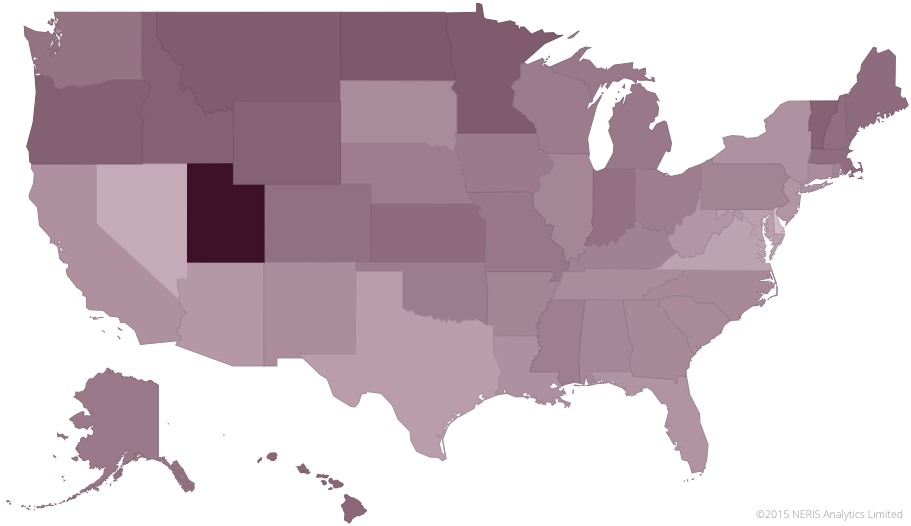
States and Regions:
Once again, we see a strong representation with the State of Utah and the State of Nevada showing a clear contrast between the neighbors. But based on the numbers gathered here, the upper Mid-West is where many people who decide with their hearts migrate.
Utah, with its strong Mormon influences, stresses the importance of family and community, which lines up with the supportive nature of those who test high for the Feeling trait. Idaho and Wyoming also have these influences, only to a slightly lesser degree.
Judging / Prospecting
Individuals who test high for Judging are those who are decisive and who like to have a clear set of standards from which to work. They like things to have a well-defined beginning, middle and end, and they honor such agendas by meeting deadlines and so on. Those who test high for Prospecting enjoy a more free-spirited outlook on life. They often improvise, choose to keep their options open and are more relaxed about work and life in general. For this scale, Conscientiousness would be the most likely equivalent among the Big Five domains.
Judging (more purple) vs. Prospecting (less purple)
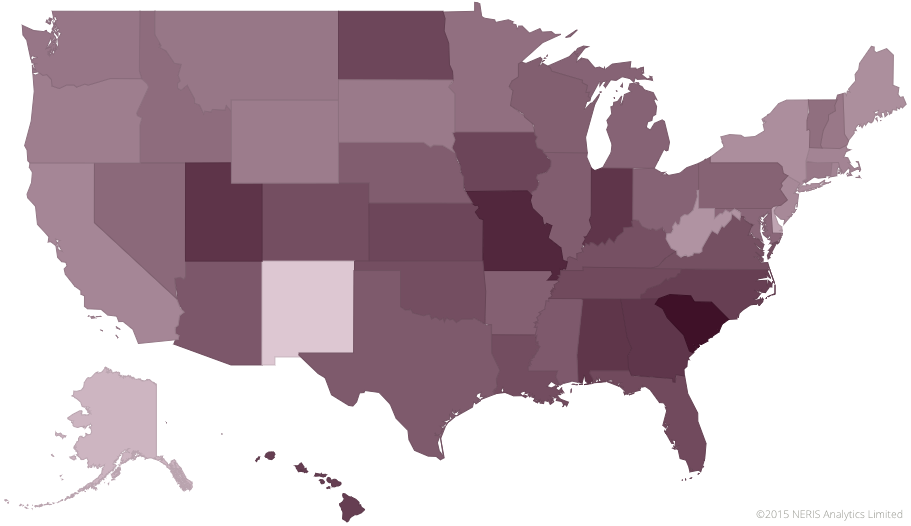
States and Regions:
One more piece to the puzzle which is the state of New Mexico. Combine their strong leaning toward both Prospecting and their intuitive style of gathering information, and we’re left with a state ripe for working with new or imaginative ideas. While practical miners, farmers and manufacturers keep the New Mexican economy afloat, tourism adds a lot to its economy because of The Land of Enchantment’s unique offerings. Known for majestic and mystical landscapes, its history of famous outlaws, and its legions of artists and visionaries, one can imagine the attraction for those who approach life in a more renegade fashion.
Once again, this map also reinforces the view of the South and the Southeast as having a more practical and orderly approach to life with their straightforward values. The results from the Northeast and the West and Northwest consistently suggest a large percentage of people who are more open to new ideas.
Turbulent / Assertive
The Turbulent and Assertive traits underpin all others. They point to one’s emotional stability and comfort with oneself. They describe how confident people are in the things they do and decide. Those who test as more turbulent individuals are self-conscious, driven and perfectionistic. Their assertive cousins are calmer and more relaxed. They feel more self-assured about what they do and about the things they decide.
Turbulent (more purple) vs. Assertive (less purple)
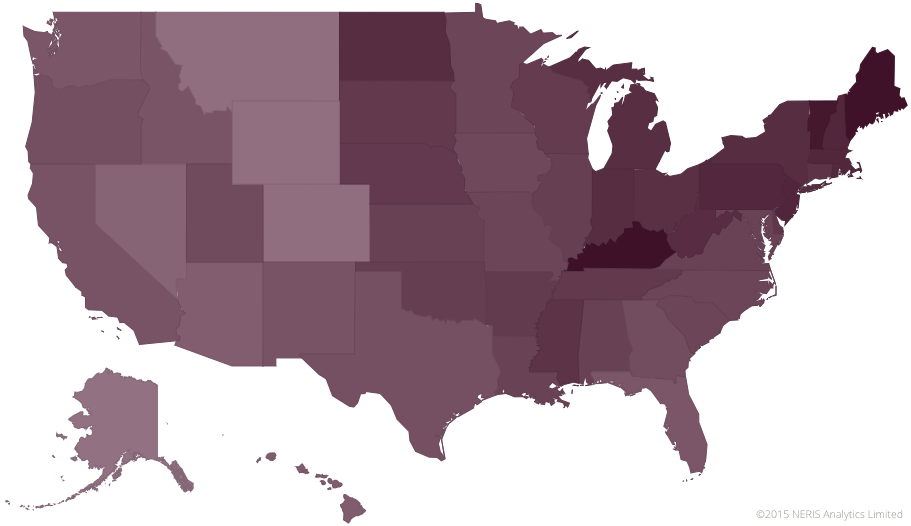
States and Regions:
A good analogy for the difference between Turbulent and Assertive regions might be the comparison of the reputation of two major cities in Turbulent and corresponding regions – a trait psychology tale of two cities, if you will.
In the heart of the turbulent Northeast we have NYC, with a reputation for being driven and neurotic. The people there live in a “city that never sleeps”. There’s always a sense of great busyness. If you’ve ever ridden with an aggressive New York cab driver who was constantly yelling at all the other drivers (and perhaps even you), the Turbulent stereotype is already firmly planted in your mind.
Contrast that with less turbulent Los Angeles. Sure, they have their share of driven people. However, when we think of L.A., we think of convertibles, beaches with palm trees and barbecues. Life may not necessarily be that much slower there. California still shines purple, just a lesser shade. And it’s true that many of its residents migrated from other more turbulent places, perhaps bringing some of their self-consciousness with them. Nonetheless, the more mellow inhabitants of L.A. have a reputation for being more relaxed. And everything closes at a reasonable hour in Los Angeles.
What someone might say to a passerby on the streets of NYC may not be something we want to repeat. Meanwhile, in L.A., the passing comment of choice is likely to be “Have a nice day”. In fact, some swear the cheery phrase originated there.
We might be dealing a bit heavily in stereotypes, but the map speaks for itself. Clichés exist because they offer some truth. The Northeast (and parts of the Midwest) clearly tests more turbulent than other parts of the country. The further west, the more relaxed and confident the respondents in this study. Alaska, Wyoming and Colorado rank on our survey as the most relaxed and confident of all. (We anticipate jokes about Colorado’s recent legalization of marijuana about now.)
Coda
The take away message is not about how separate the preferences of the people of the United States are, but how diverse they are as a people. The slogan on US coins reminds us that “Out of many, one.” (E pluribus unum.) While that applies to many things, this research shows that it also applies to personalities.
There are clearly many differing people in the United States, with differing traits, who may even show a tendency to flock together. This is probably no more unique to the United States than it is to the rest of the world (which we will also cover soon) – but the United States prides itself on being a “melting pot”. Why not apply the same principles to personality traits?
It’s generally accepted by those who study personality types that each type brings something of value to the table. Forgetting that has the potential to create contention and division. While significant percentages of people may flock together with those who are most like them, it doesn’t mean that those who are different should be seen as outsiders or contributing less. They just contribute something different to the same country.

